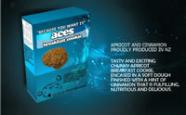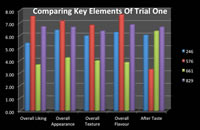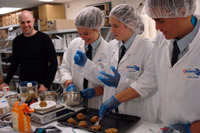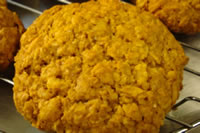Professional cookie development
Sancta Maria College students Alex Rooza, Chelsea Couchman, Elliott Diver and Summer Brooke, collectively known as 'The Aces', created a nutritious and convenient breakfast-replacement cookie for their Year 13 Food Technology project, done as part of the NZIFST/CREST Student Product Development Challenge 2011.
The project started when Futureintech Facilitator Gay Watson introduced The Aces to food technologists Sam Harper and Katie Hatton from Bluebird Foods. Sam and Katie became the team's industry mentors giving advice and feedback throughout the year.
Choosing a brief
Sam and Katie proposed four possible briefs for the team to choose from, each targeting specific needs and demographics. These included a multigrain bar for baby-boomers, a sweet dipping snack for children or a popcorn snack bar.
The brief that appealed the most to the team was the brief for a breakfast-replacement cookie for busy people who often skipped breakfast, as they felt that the cookie had more scope for development than the other options and their research showed there were very few products like this available in New Zealand supermarkets.
The brief from Bluebird specified that the team would be responsible for the entire concept development of the cookie, including "product and packaging, product development based on concept and market research, and identifying key health or nutritional claims that would be associated with this product".
The team then created a plan for the weeks ahead, scheduling research, trialling and taste testing as well as regular consultations with the Bluebird team.
Research
The girls started their research by looking into what constitutes a 'good breakfast' on a nutritional level.
"From the information we found we prioritised important nutrients such as calcium, fibre, protein and carbohydrates for our cookie recipe," they said. "We also needed to we control the amount of fat in the cookie which was a problem as we will also need to ensure the cookie also tasted good."
After looking at the content of some overseas breakfast bars, the team came up with a shortlist of four basic recipes to start with. All four recipes included a base of oatmeal with selected fruit and nuts.
Trialling
The team started a period of trialling and testing of different recipes. The first recipe had a base of rolled oats, combined with sultanas, coconut, sunflower seeds and apricot. Butter was used as a binding agent and sugar and golden syrup provided sweetness.
This recipe was adapted into six different variations, each trialling different amounts of flavourings as well as looking for substitutes for the butter and sweeteners to create a far healthier bar for breakfast that would still be delicious and hold together.
To improve the potential shelf-life of the cookie, the team incorporated dried – rather than fresh – fruit and also conducted tests for water loss.
"As water content affects shelf life and bacterial growth, we measured the amount of water loss by weighing the mixture before cooking, after cooking and two days after cooking. Baking is a sterilisation process which kills bacteria in raw ingredients but when exposed to the air after cooking, bacteria can be reintroduced to the product. So we relied on low water content in our ingredients to help inhibit bacterial growth."
Each recipe was then trialled in a series of test tastes with students. Their feedback was collected with a template that rated each cookie on a hedonic scale from 1-5 and asked specific questions about appearance, smell, taste and texture. The team then compiled this information into graphs.
"By looking at our graphs, we were able to establish clear favourites amongst the stakeholders. We could also see the favourite cookie in all of the different categories broken down. This helped us improve the cookie that would become our final product."
The team's research and trialling helped them create a recipe that incorporated the best results from the taste tests and also improved the unhealthier aspects of the initial recipe. Changes included using margarine instead of butter for the consistency, and treacle almonds and brown sugar instead of white sugar for sweetness. Coconut was removed to reduce the fat content and wheat bran and wholemeal flour were also added to increase the wholegrain component.
The team's effort to reduce the overall fat content when creating their final recipe included using the requirements for the New Zealand Heart Foundation's 'Tick of Approval' as a guide.
"We then made a bulk batch, divided one in half with slight modifications to every batch. Baking times for each batch were also slightly different. This helped us to work out optimum cooking against colour of the baked product and moisture loss. From this test we took the best product/recipe to the bluebird lab to make a prototype."
The team made two batches of the prototype at the Bluebird lab under the guidance of Sam Harper. Sam's experience and knowledge as a food technologist was invaluable to the team's project as he suggested additions to the recipe such as lecithin, glycerine and invert syrup that further improved the flavour, reduced the sugar and increased the binding properties of the cookie.
The final prototype was then given a final taste back at the school with very positive results.
To finish off their project, the team researched the packaging and labelling requirements required for the product if it were to be mass manufactured. This meant detailed analysis of the nutritional aspects of the final cookie, including energy, fat, carbohydrate, dietary fibre and sodium content per serving. The team also compiled a complete list of ingredients, identifying potential allergens, as well as storage information in order to meet the requirement of the New Zealand Food Safety Authority. These elements were then incorporated into the team's final packaging design.
The Aces compared the nutritional aspects of their final product with other cookies on the market, and were pleased to see that their cookie was healthier in most areas. The Ace's hard work and thorough research for this project gained them Achievement Standards 90620, 90683, and 90682, and they were awarded a highly commended in the Upper North Island section of the 2011 NZIFST/CREST Student Product Development Challenge.
Teacher Comment
These students were lovely to work with. They worked well as a team as they all had individual strengths. Elliott was very good at Maths and compiled the surveys, produced tables and graphs; Chelsea was very organised, led the group and ensured they kept on task; Summer was keen on the practical aspects and enjoyed trying alternative ideas; and Alex was a quiet worker who was good with research and poster ideas. They spent a great deal of time trialling, testing and modelling in order to get their product looking and tasting just right.
They also had great mentors in Katie and Sam from Bluebird and Gay Watson from Futureintech who were very encouraging and motivated the students throughout the project.




